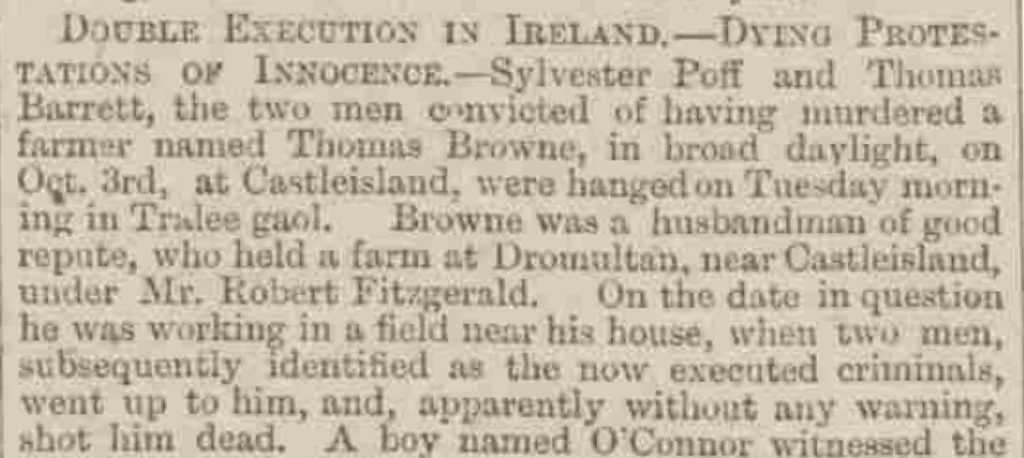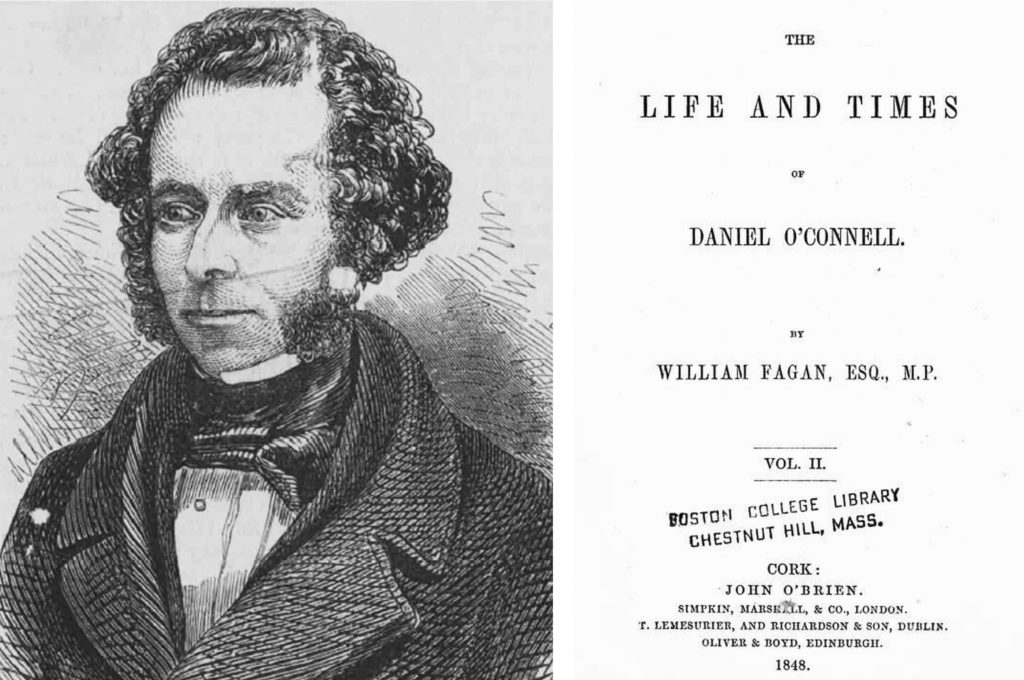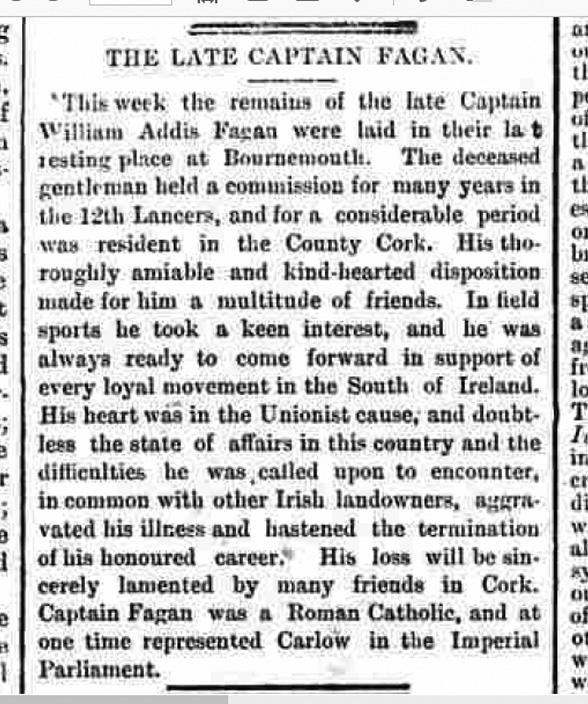There is an anti-Irish feeling so predominant among the English members [of parliament] as to render them totally unfit to legislate for Ireland – Daniel O'Connell to William Trant Fagan, 26 October 1833
Michael O’Donohoe’s innocuous note on Dromultan Estate opens up volumes in Irish history.

The name associates with Thomas Browne, murdered in 1882.1

Dromultan was also known as Fagan’s Estate. Captain William Addis Fagan (1832-1890) MP for Carlow for the years 1868-74, was the son of Cork MP, William Trant Fagan (1801-1859) of Feltrim House, Knockrea, Cork, author of The Life and Times of Daniel O’Connell.2

In addition to land at Dromultan and also at Crag, it would seem that the Fagan family had put down roots in Killarney for in 1871, Captain Fagan married Frances, daughter of Daniel Mahony of Dunloe Castle, Killarney.3
The couple had two children.4 Captain Fagan died on 13 March 1890 at Bournemouth. He was described as always ready to support the loyal causes of the South of Ireland.

The Fagan Estate was sold in 1909 after negotiations of almost five years, the sale completed at Fitzgerald’s Imperial Hotel, Castleisland.
Dominic O’Daly, Bishop Elect of Coimbra
Another historical association to Dromultan is Dominic (or Daniel) O’Daly (1595-1662), Bishop Elect of Coimbra , author of Initium, incrementum et exitus familiae Geraldinorum Desmoniae comitum (1655) or The Geraldines, Earls of Desmond and the persecution of the Irish Catholics.5
The following verse is attributed to the O’Dalys of Dromultan, composed, it is suggested, during the war of 1641; the red fox symbolising Cromwell’s ‘red soldiers’:
Carmen Antiqum Hibernicum Air – Modereen Ruagh Good morrow to you, Fox and good morrow to you, sir, And what did you do with my gander? That fine fat goose I stole from you, You'll find in the pond there yonder. Though the fox run fast, oh! we run him down at last In the wilds of wild Sliabh Luachra, And when his race was run, oh! it's then we had the fun Ullogoneing Modereen ruagh, ruagh, Chorus – Modereen ruagh, rue, rue, rue, rue, rue, Modereen rue, na ghena, Modereen ruagh, ne lian se fluis, Agus nau re beiree slaun dha.6
_______________________________
1 See page, 'Browne, Poff & Barrett' (IE MOD/86). See also IE MOD/58/58.4/58.4.4 for reference to George Bateman of 'Dromultin' Other spellings include Dremulton. There are two townlands near Castleisland by the name of Dromultan in the parishes of Killeentierna and Castleisland. 2 Vol I published in 1847, Vol II 1848. The wife of William Trant Fagan was Mary, daughter of Charles Addis Esq. William Addis Fagan had two brothers, Charles Addis and Hornby and a sister, Mary, who married in 1856 Daniel Francis Leahy Esq JP, third son of Daniel Leahy Esq DL of Shanakiel House, Co Cork. Feltrim House and demesne, Blackrock Road, Cork was for sale in the Incumbered Estates Court in 1858 in the matter of James L Notter and Margaret Notter. It was subsequently associated with Robert Lambkin Esq. 3 At the time of Griffiths Valuation, Fagan was leasing Woodlawn House, Killarney to Francis Bland. See collection for note on Woodlawn House and the Earls of Kenmare. In the Court of Chancery, 1856, William Fagan Esq MP petitioned Michael M Sheehy (re John Sheehy or McSheehy) of Killarney, deceased. Fagan also owned land in Duhallow. 4 William Charles Trant Fagan (1877-1944) and Maureen Elizabeth Fagan (1875-1962). 5 In 1866, a discussion about the death of Gerald, Earl of Desmond by 'Good Times' (perhaps John Florence Purdon Macarthy: see page, 'Visitors' Comments on Castleisland' (IE MOD/79)) alluded to one John Daly, 'a near relative of Dominic O'Daly of Cuggeragh [Coolnageragh?] and Drumulton, Bishop of Coimbra'. Letter published in Tralee Chronicle, 31 July 1866. Initium is described in the Dictionary of National Biography (Vol 13) as 'an account of the Geraldine Earls of Desmond in the south of Ireland, from the establishment of their progenitors there by Henry II to the death of Earl Gerald in the reign of Elizabeth. The second part is devoted to an account of the persecution of Roman Catholics in Ireland, after the extinction of the Geraldine earls. Members of the Dominican order who had recently met their death in Ireland are specially noticed. Among them were several connected with the Irish college at Lisbon, including Terence Albert O'Brien, bishop of Emly, who was hanged on the surrender of Limerick to Ireton in 1651. Daly was supplied with information by Dominicans who had come from Ireland to Lisbon and Rome'. Further reference to the O'Daly clan in 'The Legend of Aileen Aroon', Nine White Deer and other Irish legends (2015) pp19-28. 6 Letter to the editor of the Tralee Chronicle from 'Kerriensis' (see note on John Florence Purdon Macarthy in IE MOD/79) in 1860. Three verses published in English. 'Kerriensis' wrote, 'The O'Dalys of Cuggeragh near Castleisland were for ages hereditary poets and historians to the great families of M'Carthy, O'Donoghue and the Earls of Desmond ... the authorship is ascertained by the mention of Shabh Loughra (now Slieve Logher), the locality in which Drumultanmore, the old patrimony of the O'Dalys, is situated'. The verse was subsequently reprinted with a Latin translation in the Tipperary Vindicator, 19 February 1861, in which the editor suggested the fox alluded to the 'red soldiers' of Cromwell's army. The Halls, in their Ireland, its Scenery, Character (1841, p195) provide a description of the piper, Gandsey, playing a similar tune from his repertoire of old Irish airs.


